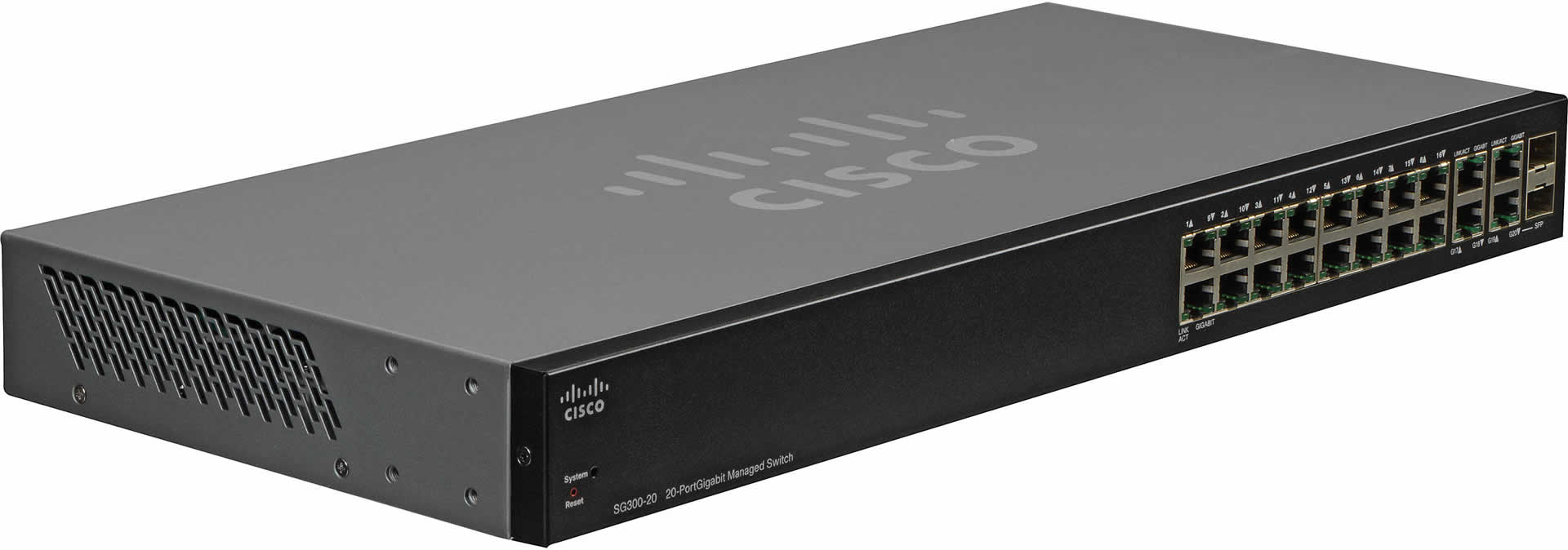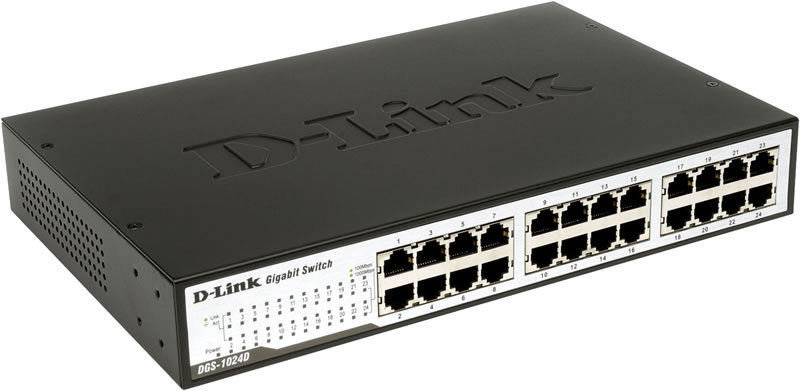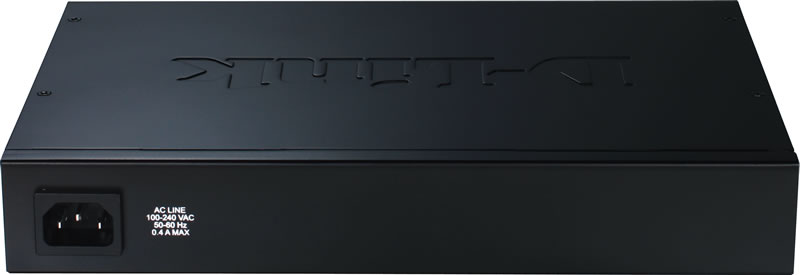Cisco - SG300-20
Switch 18 ports 10/100/1000 gigabit + 2 Combo mini-GBIC, adminitrable- Codart : SG300-20P
- Dimensions unitaires : 440 x 36.83 x 202.5 mm
- Poids unitaire : 2,17 kg
- Dimensions unitaires : … x … x … cm
- Poids en flight-case (X1) : … kg
Documents à télécharger
Détails produit
PRODUCT HIGHLIGHTS
18x 10/100/1000 Ports
2x Combo mini-GBIC Ports
QoS Support
IPv4 / IPv6 Support
Advanced Security Management
Auto Voice VLAN Capabilities
Energy-Efficient
Mac, Windows, Linux Compatible
The Cisco SG300-20 20-Port 10/100/1000 Gigabit Managed Switch provides a reliable foundation for your business network. It delivers the features you need to improve the availability of your critical business applications, protect sensitive data and optimize network bandwidth to deliver information and applications more effectively. Setting up and the usage of the Cisco SG300-20 is a breeze and it provides the ideal combination of affordability and capabilities for small businesses and helps you create a more efficient, better-connected workforce.
The Cisco SG300-20 has the advanced security management capabilities and network features you need to support business-class data, voice, security and wireless technologies. At the same time, it is simple to deploy and configure, allowing you to take advantage of the managed network service your business requires.
Secure Desktop Connectivity
The Cisco SG300-20 switch can simply and securely connect employees working in small offices with each other and with all of the servers, printers and other devices they use. High performance and reliable connectivity helps speed file transfers and data processing, improves network uptime and keeps your employees connected and productive.
Secure Wireless Connectivity
The Cisco SG300-20 switch allows employees to work productively from conference rooms and common areas, collaborate in any office and access business applications from wherever they are. Gigabit Ethernet connectivity helps ensure that your employees have the bandwidth and performance they need to make the most of mobile productivity. And with embedded security, your employees can work with confidence, knowing that only authorized users can access applications and network devices.
Unified Communications
As a managed network solution, the Cisco SG300-20 switch provides the performance and advanced traffic-handling intelligence you need to deliver all communications and data over a single network. The Cisco SG300-20 is rigorously tested to help ensure easy integration and full compatibility with Cisco and other products, providing a complete small business solution.
Highly Secure Guest Connectivity
The Cisco SG300-20 switch lets you extend highly secure network connectivity to guests in a variety of settings, such as a hotel, an office waiting room or any other area open to nonemployee users. Using powerful but easy-to-configure security and traffic segmentation capabilities, you can isolate your vital business traffic from guest services and keep guests’ network sessions private from each other.
High Performance and Reliability
The Cisco SG300-20 Switch is rigorously tested to deliver the high availability and performance you expect from a Cisco switch. The solution speeds up file transfer times and improves slow, sluggish networks, while keeping your vital business applications available and preventing costly downtime. As a managed switching solution, the Cisco SG300-20 also gives you the flexibility to manage and prioritize high-bandwidth traffic such as voice. That means you can empower your employees with state-of-the-art communication and productivity solutions, without draining the performance of your other business applications.
Fast, Easy Setup and Configuration
The Cisco SG300-20 switch is designed to be easy to use and managed by small businesses and the partners who serve them. The included device manager software provides an intuitive, web-based interface to simplify setup, security and quality of service (QoS) traffic prioritization, allowing even users without IT expertise to configure the switch in minutes. It also provides a Cisco FindIT Network Discovery Utility. This utility works through a simple toolbar on the user’s web browser to discover Cisco devices in the network and display basic information, such as serial numbers and IP addresses, to aid in the configuration and deployment of Cisco Small Business products. The Cisco SG300-20 switch uses Cisco Discovery Protocol as well as Link Layer Discovery Protocol (LLDP-MED) to automatically detect all the devices connected to your network and then automatically configures them for the appropriate connectivity and instructs the devices to use appropriate voice VLAN or QoS parameters. For more advanced capabilities and hands-on control, the switch supports Smartport roles which configure the ports with specific levels of Security, QoS and availability according to the type of connected device, based on Cisco best practices and pretested configurations. The Auto Smartports feature applies the intelligence delivered through the Smartport roles and applies it automatically to the port based on the devices discovered over CDP or LLDP-MED. This facilitates zero touch deployments. Although the Cisco SG300-20 is designed to be deployed without using a command-line interface, Cisco Textview is available for those who prefer to use text-based configuration. Together, these features reduce the time your staff must devote to network deployment, management and troubleshooting.
Strong Security
The Cisco SG300-20 switch provides a high level of security and gives you fine-grained control to safeguard your network from unauthorized users. It’s advanced security features include:
Embedded security to protect management data traveling to and from the switch and encrypt network communications.
Extensive access control lists to restrict sensitive portions of the network from unauthorized users and guard against network attacks.
Guest virtual LANs to let you provide Internet connectivity to nonemployee users while isolating critical business services from guest traffic.
Support for advanced network security applications such as IEEE 802.1X port security to tightly limit access to specific segments of your network.
Security mechanisms such as, Bridge Protocol Data Unit Guard and broadcast/multicast/unknown unicast storm control, protect the network from invalid configurations or malicious intent.
Secure Core Technology helps ensure that the switch will receive and process management and protocol traffic no matter how much traffic is received.
IP Telephony Support
The Cisco SG300-20 switch includes embedded QoS intelligence to prioritize delay-sensitive services such as voice and video, simplify unified communications deployments and help ensure consistent network performance for all services. For example, automated voice VLAN capabilities let you plug any IP phone (including third-party phones) into your IP telephony network and receive an immediate dial tone. The switch automatically configures the device with the right VLAN and QoS parameters to prioritize voice traffic.
Advanced Network Management Capabilities
As a managed switch, the Cisco SG300-20 switch lets you use a variety of advanced features to control traffic over your network. Features include:
Static routing/Layer 3 switching between VLANs: This capability allows you to segment your network into separate workgroups and communicate across VLANs without degrading application performance. As a result, you can manage internal routing with your switch and dedicate your router to external traffic and security, helping your network runs more efficiently.
IPv6 support: As the IP network addressing scheme evolves to accommodate more devices, you can make sure that your network is ready. The The Cisco SG300-20 switch provides native support for IPv6, the newest version of the Internet Protocol, as well as the previous IPv4 standard. As a result, you will be able to move up to the next generation of networking applications and operating systems without an extensive equipment upgrade.
Dual image support: With the ability to maintain dual images of your switches, you can perform software upgrades without having to take the network offline and without worrying about an outage during an upgrade.
Remote management: Using Simple Network Management Protocol, you can set up and manage all switches and other Cisco devices in your network remotely, instead of having to directly connect to them.
Optimal Energy Efficiency
The Cisco SG300-20 « green » switch designed with power-saving features optimizes power use to protect the environment and reduces energy costs, without compromising performance. Power-saving features include:
The latest application-specific integrated circuits, using low-power 65-nanometer technology (these chipsets allow for lower power consumption and thinner, more efficient designs).
Embedded intelligence to adjust signal strength based on cable length.
Fanless design which reduces power consumption, increases reliability and provides quieter operation.
Expansion Ports
The Cisco SG300-20 switch provides more ports per Gigabit Ethernet switch than traditional switch models, giving you more flexibility to connect and empower your business. It also offers mini gigabit interface converter (mini-GBIC) expansion slots that give you the option to add fiber-optic or Gigabit Ethernet uplink connectivity to the switch. With the ability to increase the connectivity range of the switch, you have more flexibility to design your network around your unique business environment and to easily connect switch on different floors or across the business.
Peace of Mind and Investment Protection
The Cisco SG300-20 switch offers the reliable performance, investment protection and peace of mind you expect from a Cisco switch. When you invest in the Cisco SG300-20 switch, you gain the benefit of:
Cisco Small Business Investment Protection program, which lets you upgrade your Cisco SG300-20 switch to another Cisco Small Business or Cisco Catalyst switch in the future and receive credit for the value of the switch (available only in the United States and Canada).
Rigorous testing to help ensure easy integration and compatibility with other Cisco networking and communications products, including the complete Cisco Small Business portfolio.
Performance
Capacity in Mpps (64-byte packets): 29.76
Switching Capacity in Gbps: 40.0
Layer 2 Switching
Spanning Tree Protocol: Standard 802.1d Spanning Tree support
Fast convergence using 802.1w (Rapid Spanning Tree), enabled by default
Multiple Spanning Tree instances using 802.1s
Port Grouping: Support for IEEE 802.3ad Link Aggregation Control Protocol
Up to 8 groups
Up to 8 ports per group with 16 candidate ports for each (dynamic) 802.3ad link aggregation
VLAN: Support for up to 256 VLANs simultaneously (out of 4096 VLAN IDs)
Port-based and 802.1Q tag-based VLANs
MAC-based VLAN
Management VLAN
Private VLAN Edge, also known as protected ports, with multiple uplinks
Guest VLAN
Unauthenticated VLAN
Voice VLAN: Voice traffic is automatically assigned to a voice-specific VLAN and treated with appropriate levels of QoS
Q-in-Q VLAN: VLANs transparently cross a service provider network while isolating traffic among customers
Generic VLAN Registration Protocol/Generic Attribute Registration Protocol: Protocols for automatically propagating and configuring VLANs in a bridged domain
Dynamic Host Configuration Protocol Relay at Layer 2: Relay of DHCP traffic to DHCP server in different VLAN. Works with DHCP Option 82
Internet Group Management Protocol Versions 1, 2 and 3 snooping: IGMP limits bandwidth-intensive multicast traffic to only the requesters; supports 256 multicast groups (source-specific multicasting is also supported)
IGMP Querier: IGMP querier is used to support a Layer 2 multicast domain of snooping switches in the absence of a multicast router.
Head-of-Line (HOL) Blocking: HOL blocking prevention
Layer 3
IPv4 Routing: Wirespeed routing of IPv4 packets
Up to 32 static routes and up to 32 IP interfaces
Classless Inter-Domain Routing: Support for CIDR
DHCP Relay at Layer 3: Relay of DHCP traffic across IP domains
User Datagram Protocol Relay: Relay of broadcast information across Layer 3 domains for application discovery or relaying of BootP/DHCP packets
Security
Secure Shell Protocol: SSH secures Telnet traffic to and from the switch; SSH v1 and v2 are supported
Secure Sockets Layer: SSL support: Encrypts all HTTPS traffic, allowing highly secure access to the browser-based management GUI in the switch
IEEE 802.1X (Authenticator role): RADIUS authentication and accounting, MD5 hash; guest VLAN; unauthenticated VLAN, single/multiple host mode and single/multiple sessions
Supports time-based 802.1X
Dynamic VLAN assignment
STP Bridge Protocol Data Unit Guard: A security mechanism to protect the network from invalid configurations.
A port enabled for BPDU Guard is shut down if a BPDU message is received on that port
Secure Core Technology: Ensures that the switch will receive and process management and protocol traffic no matter how much traffic is received
Layer 3 Isolation: Allow/disallow routing between IP subnets or directly connected IP networks
Layer 2 Isolation Private VLAN Edge (PVE) with community VLAN: PVE (also known as protected ports) provides Layer 2 isolation between devices in the same VLAN, supports multiple uplinks
Port Security: Locks MAC addresses to ports, and limits the number of learned MAC addresses
RADIUS/TACACS+: Supports RADIUS and TACACS authentication. Switch functions as a client
Storm Control: Broadcast, multicast and unknown unicast
DoS Prevention: DoS attack prevention
Congestion Avoidance: A TCP congestion avoidance algorithm is required to minimize and prevent global TCP loss synchronization.
ACLs: Support for up to 512 rules
Drop or rate limit based on source and destination MAC, VLAN ID or IP address, protocol, port, differentiated services code point/IP precedence, TCP/ UDP source and destination ports, 802.1p priority, Ethernet type, Internet Control Message Protocol packets, IGMP packets, TCP flag
Quality of Service
Priority Levels: 4 hardware queues
Scheduling: Strict priority and weighted round-robin
Queue assignment based on DSCP and class of service (802.1p/CoS)
Class of Service: Port based; 802.1p VLAN priority based; IPv4/v6 IP precedence/type of service/DSCP based; Differentiated Services (DiffServ); classification and re-marking ACLs, trusted QoS
Rate Limiting: Ingress policer; egress shaping and rate control; per VLAN, per port and flow based
Standards
IEEE 802.3 10BASE-T Ethernet, IEEE 802.3u 100BASE-TX Fast Ethernet, IEEE 802.3ab 1000BASE-T Gigabit Ethernet, IEEE 802.3ad LACP, IEEE 802.3z Gigabit Ethernet, IEEE 802.3x Flow Control, IEEE 802.1D (STP, GARP, and GVRP),IEEE 802.1Q/p VLAN, IEEE 802.1w RSTP, IEEE 802.1s Multiple STP, IEEE 802.1X Port Access Authentication, IEEE 802.3af, IEEE 802.3at, RFC 768, RFC 783, RFC 791, RFC 792, RFC 793, RFC 813, RFC 879, RFC 896, RFC 826, RFC 854, RFC 855, RFC 856, RFC 858, RFC 894, RFC 919, RFC 922, RFC 920, RFC 950, RFC 951, RFC 1042, RFC 1071, RFC 1123, RFC 1141, RFC 1155, RFC 1157, RFC 1350, RFC 1533, RFC 1541, RFC 1542, RFC 1624, RFC 1700, RFC 1867, RFC 2030, RFC 2616, RFC 2131, RFC 2132, RFC 3164, RFC 3411, RFC 3412, RFC 3413, RFC 3414, RFC 3415, RFC 2576, RFC 4330, RFC 1213, RFC 1215, RFC 1286, RFC 1442, RFC 1451, RFC 1493, RFC 1573, RFC 1643, RFC 1757, RFC 1907, RFC 2011, RFC 2012, RFC 2013, RFC 2233, RFC 2618, RFC 2665, RFC 2666, RFC 2674, RFC 2737, RFC 2819, RFC 2863, RFC 1157, RFC 1493, RFC 1215, RFC 3416
IPv6
IPv6: IPv6 host mode
IPv6 over Ethernet
Dual IPv6/IPv4 stack
IPv6 neighbor and router discovery
IPv6 stateless address auto-configuration
Path maximum transmission unit discovery
Duplicate address detection
ICMP version 6
IPv6 over IPv4 network with Intra-Site Automatic Tunnel Addressing Protocol support
IPv6 QoS: Prioritize IPv6 packets in hardware
IPv6 ACL: Drop or rate limit IPv6 packets in hardware
Multicast Listener Discovery Snooping: Deliver IPv6 multicast packets only to the required receivers
IPv6 Applications: Web/SSL, Telnet server/SSH, ping, traceroute, Simple Network Time Protocol, Trivial File Transfer Protocol, SNMP, RADIUS, syslog, DNS client, protocol-based VLANs
IPv6 RFCs Supported: RFC 2463 – ICMP version 6
RFC 3513 – IPv6 address architecture
RFC 4291 – IPv6 addressing architecture
RFC 2460 – IPv6 specification
RFC 2461 – Neighbor discovery for IPv6
RFC 2462 – IPv6 stateless address auto-configuration
RFC 1981 – Path MTU discovery
RFC 4007 – IPv6 scoped address architecture
RFC 3484 – Default address selection mechanism
RFC 4214 – ISATAP tunneling
RFC 4293 – MIB IPv6: Textual conventions and general group
RFC 3595 – Textual conventions for IPv6 flow label
Management
Web User Interface: Built-in switch configuration utility for easy browser-based device configuration (HTTP/HTTPS). Supports configuration, system dashboard, system maintenance and monitoring
SNMP: SNMP versions 1, 2c, and 3 with support for traps, and SNMP version 3 user-based security model
Remote Monitoring: Embedded RMON software agent supports 4 RMON groups (history, statistics, alarms and events) for enhanced traffic management, monitoring and analysis
IPv4 and IPv6 Dual Stack: Coexistence of both protocol stacks to ease migration
Firmware Upgrade: Web browser upgrade (HTTP/HTTPS) and TFTP
Upgrade can be initiated through console port as well
Dual images for resilient firmware upgrades
Port Mirroring: Traffic on a port can be mirrored to another port for analysis with a network analyzer or RMON probe. Up to 8 source ports can be mirrored to one destination port. A single session is supported
VLAN Mirroring: Traffic from a VLAN can be mirrored to a port for analysis with a network analyzer or RMON probe. Up to 8 source VLANs can be mirrored to one destination port. A single session is supported
Dynamic Host Configuration Protocol (Options 66, 67, 82, 129 and 150): DHCP Options facilitate tighter control from a central point (DHCP server) to obtain IP address, auto-configuration (with configuration file download) and DHCP relay
Text-Editable Config Files: Config files can be edited with a text editor and downloaded to another switch, facilitating easier mass deployment
Smartports: Simplified configuration of QoS and security capabilities
Auto Smartports: Applies the intelligence delivered through the Smartport roles and applies it automatically to the port based on the devices discovered over CDP or LLDP-MED. This facilitates zero touch deployments
Textview CLI: Scriptable command-line interface. A full CLI as well as a menu-based CLI is supported
Cloud Services: Support for Cisco Small Business FindIT Network Discovery Utility
Localization: Localization of GUI and documentation into multiple languages
Other Management: Traceroute; single IP management; HTTP/HTTPS; SSH; RADIUS; port mirroring; TFTP upgrade; DHCP client; BOOTP; SNTP; Xmodem upgrade; cable diagnostics; ping; syslog; Telnet client (SSH secure support)
Power Efficiency
Energy Detect: Automatically turns off power off on Gigabit Ethernet RJ-45 port when detecting link down
Active mode is resumed without loss of any packets when the switch detects the link up
Cable Length Detection: Adjusts the signal strength based on the cable length. It reduces the power consumption for cables shorter than 10 m
General Features
Jumbo Frames: Frame sizes up to 10 KB supported on 10/100 and Gigabit interfaces
MAC Table: Up to 8000 MAC addresses
Discovery
Bonjour: The switch advertises itself using the Bonjour protocol
Link Layer Discovery Protocol (802.1ab) with LLDP-MED extensions: LLDP allows the switch to advertise its identification, configuration and capabilities to neighboring devices that store the data in a MIB. LLDP-MED is an enhancement to LLDP that adds the extensions needed for IP phones
Cisco Discovery Protocol: The switch advertises itself using the Cisco Discovery Protocol
Power Consumption
Power Savings Mode: Energy Detect
Short Reach
Power Consumption Worst Case: 110V=22.6W
220V=23.3W
Heat Dissipation (BTU/hr): 79.5
Ports
Total System Ports: 20 Gigabit Ethernet
RJ-45 Ports: 18 Gigabit Ethernet
Combo Ports (RJ-45 + SFP): 2 Gigabit Ethernet Combo
Buttons
Reset button
Cabling Type
Unshielded twisted pair Category 5 or better for 10BASE-T/100BASE-TX; UTP Category 5 Ethernet or better for 1000BASE-T
LEDs
System, Link/Act, Speed
Flash
16 MB
CPU
128 MB memory
Packet Buffer Memory
4 MB
Power Supply
100-240V 47-63 Hz, internal, universal
Fan
No
Acoustic Noise
N/A
MTBF
@ 40°C (hours): 144,237
Certifications
UL (UL 60950), CSA (CSA 22.2), CE mark, FCC Part 15 (CFR 47) Class A
Environmental Requirements
Operating Temperature: 32 to 104°F (0 to 40°C)
Storage Temperature: -4 to 158°F (-20 to 70°C)
Operating Humidity: 10 to 90%, relative, noncondensing
Storage Humidity: 10 to 90%, relative, noncondensing
MINIMUM REQUIREMENTS
Web Browser: Mozilla Firefox version 2.5 or later; Microsoft Internet Explorer version 6 or later
Category 5 Ethernet network cable
TCP/IP, network adapter and network operating system (such as Microsoft Windows, Linux or Mac OS X) installed on each computer in the network











